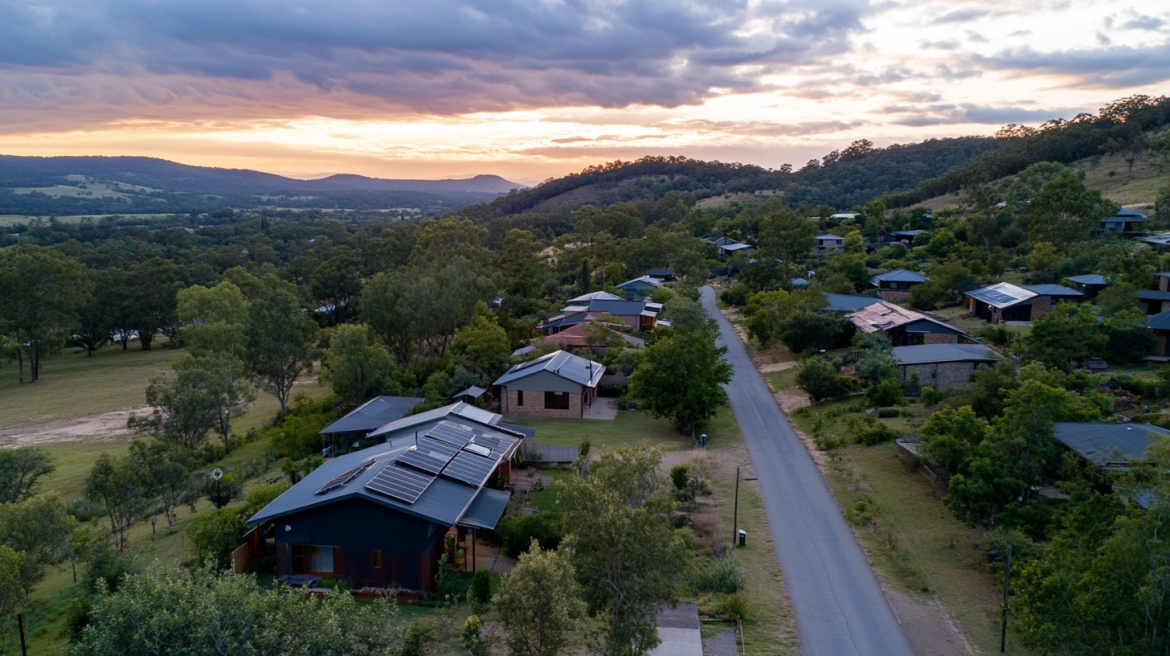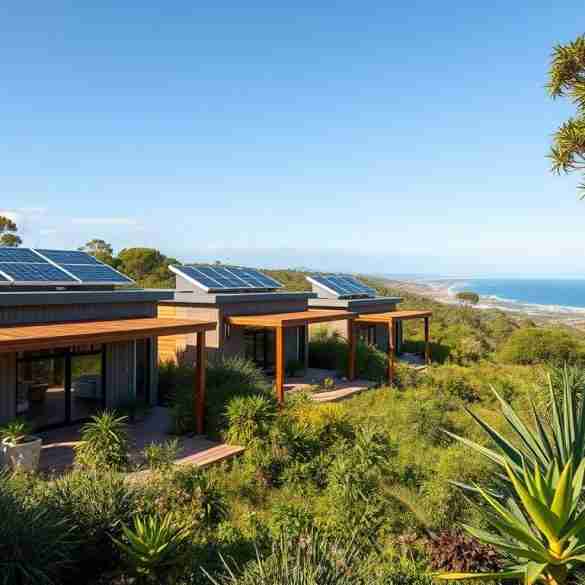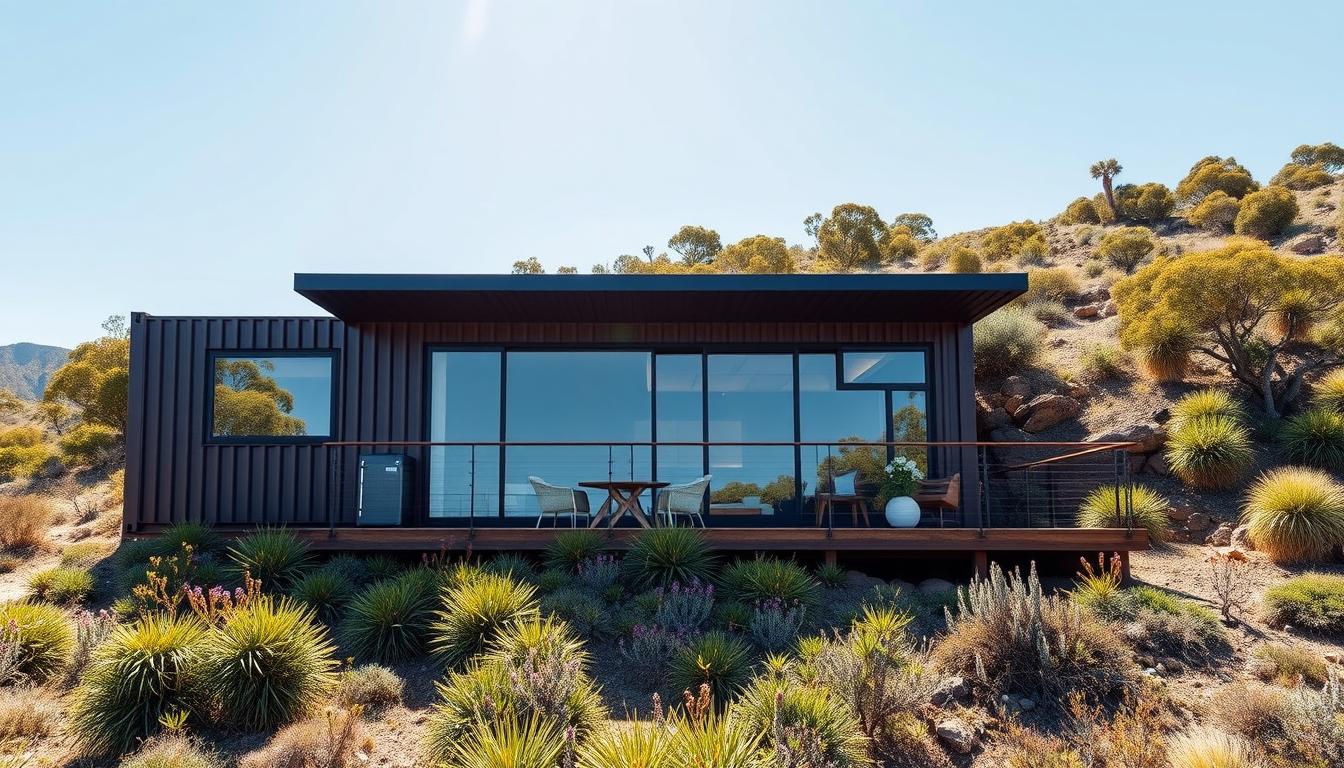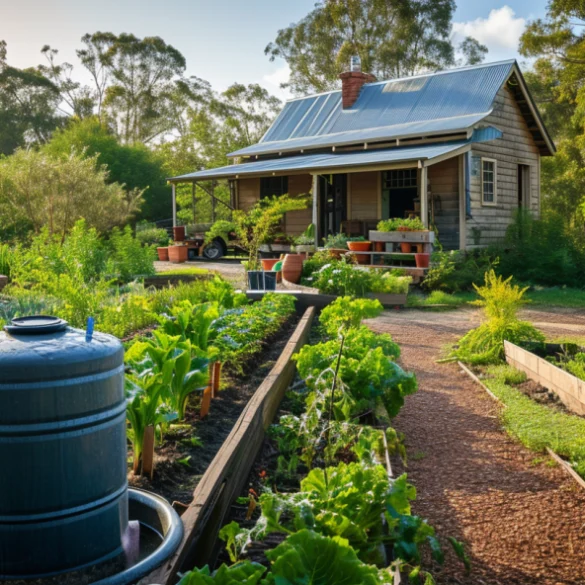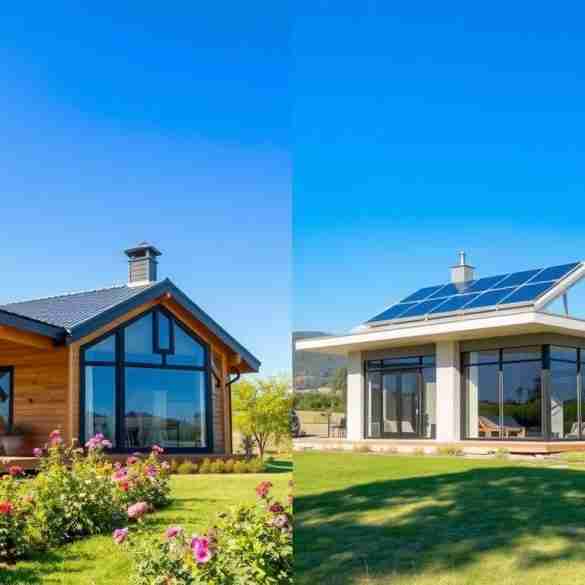Imagine living in a place where you have your own home but also a close community. You can share meals and experiences with neighbors while keeping your independence. This is what co-housing in Australia offers, changing how people live and connect.
Co-housing is more than just living together. It’s a community where everyone helps design and run their neighborhood. Whether it’s an eco-village or an urban co-op, the goal is to live sustainably and support each other.
In Australia, more people are looking for community-focused living. CoHousing Australia reports 36 projects and many more in planning. This shows the growing interest in living sustainably and affordably.
The Built for Good project in Newcastle, NSW, is a great example. Four families share a complex with private yards and a small shared space. It shows how co-housing balances privacy and community. The project also focuses on being green, using water wisely, and natural materials.
So, why are Australians choosing co-housing? It fights loneliness and isolation. Living alone can lead to mental health issues, but co-housing offers support and belonging. This is hard to find in regular housing.
Co-housing also has economic and environmental benefits. By sharing, costs and ecological impact decrease. Plus, co-housing is more resilient and adaptable because it’s designed by the community.
If you want to join the co-housing movement in Australia, there’s help available. Organizations like CoHousing Australia and Sustainable Home Magazine offer support. With more recognition of its benefits, finding or starting a co-housing project is easier than ever.
Table of Contents
Key Takeaways
- Co-housing is an intentional community where residents share resources and spaces while maintaining individual privacy.
- The co-housing movement is growing in Australia, with 36 registered projects and many more in the planning stages.
- Co-housing can combat isolation and improve mental health by providing a built-in support system and a sense of belonging.
- Sharing resources and facilities in co-housing can reduce the cost of living and ecological footprint.
- Organizations like CoHousing Australia and Sustainable Home Magazine provide resources for those interested in joining or creating a co-housing community.
Why Choose Co-Housing in Australia?
Co-housing in Australia is a great choice for those looking for affordable, sustainable living. It offers a community-focused lifestyle that’s different from traditional housing. Here are some reasons why co-housing might be right for you.

Affordability and Cost Savings
Co-housing can save you money. By sharing common spaces and utilities, costs go down. This is especially good for older women, as it helps them live more affordably.
Groups like the Sharing with Friends Foundation work to make co-housing affordable for older women. They aim to provide safe, secure homes.
Community and Shared Values
Co-housing builds a strong sense of community. Living close to neighbors and participating in activities creates lasting bonds. It’s a place where everyone supports each other.
This model is great for mental health. It encourages social interaction and a sense of purpose. This can make you feel happier and more fulfilled.
Environmental Sustainability
Many co-housing communities focus on being green. They use eco-friendly designs and practices. This helps reduce their impact on the environment.
By living sustainably, co-housing residents help create a better future. This is something more people in Australia are looking for in their homes.
Work-Life Balance
Co-housing can also improve your work-life balance. It offers amenities like co-working spaces and childcare. This makes daily life easier and less stressful.
With these amenities, you can be more productive and enjoy your family more. It’s a way to live a more balanced and fulfilling life.
| Benefit | Description |
|---|---|
| Affordability | Reduced individual expenses through shared resources and amenities |
| Community | Strong sense of belonging, mutual support, and shared values |
| Sustainability | Eco-friendly features and practices for a reduced ecological footprint |
| Work-Life Balance | On-site amenities and services that simplify daily routines and reduce stress |
When looking at housing options in Australia, consider co-housing. It offers a unique blend of affordability, community, and sustainability. It’s a chance to live a more connected and fulfilling life that matches your values.
How Does Co-Housing Work in Australia?
Co-housing in Australia is a unique way to live sustainably. It brings together families of different ages in one community. You join a group where everyone helps make decisions together.
Sustainable Home Magazine says these communities have 8-50 homes. This size helps everyone feel connected and makes it easy to meet up.
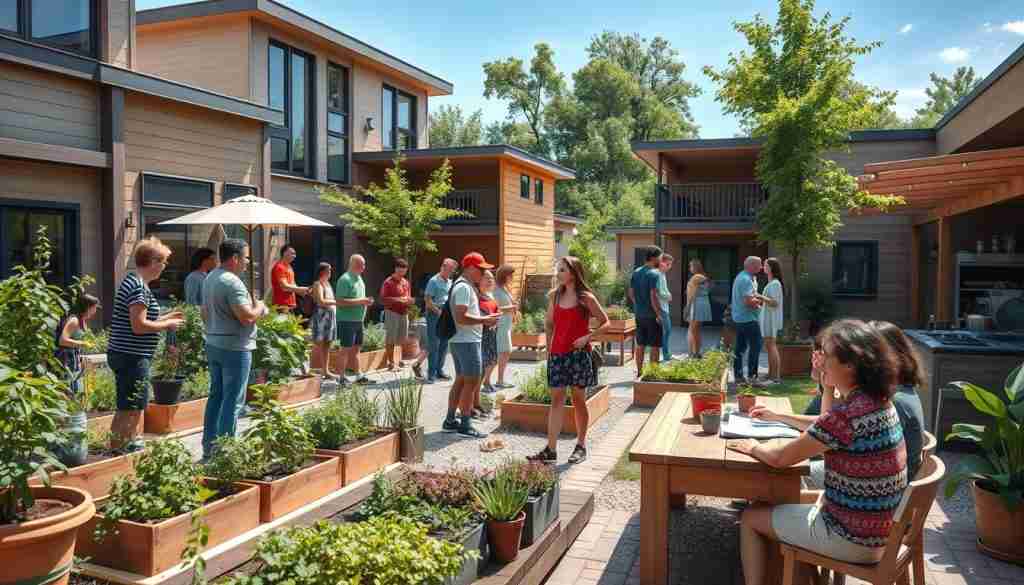
Financial Structures in Co-Housing
Joining Cohousing Australia costs $5 for a one-time fee and $35 a year. Or, it’s $25 for those who need a break. Being a member means you have a say in the community.
This way of living can be cheaper. It cuts out the costs of developers and marketing. It’s a good choice for those wanting to live sustainably.
Legal Aspects and Governance
The rules for co-housing vary by project and place. Cohousing Australia uses ideas from around the world to fit Australian needs. They aim to offer new ways to own and manage homes.
Co-Housing Agreements and Rules
When you join, you agree to follow certain rules. These rules help everyone live well together. They cover how decisions are made and how to solve problems.
Cohousing design features shared pedestrianized walkways and car-free central shared gardens for passive surveillance and safe outdoor spaces.
Managing Common Spaces and Resources
Co-housing is all about working together in shared spaces. Communities have places like:
- Cooking and dining spaces
- Meeting areas
- Play zones
- Food growing spaces
- Laundries
- Guest rooms
These spaces help people connect and live sustainably. They make homes more appealing and improve life for everyone.
| Aspect | Description |
|---|---|
| Number of Households | 8-50 |
| Shareholder Fee | $5 (one-time) |
| Annual Fee | $35 ($25 for concessions) |
| Shared Facilities | Cooking and dining spaces, meeting areas, play zones, food growing spaces, laundries, guest rooms |
Co-housing can solve many problems in Australia, like the cost of living and feeling connected. Governments help by supporting co-housing with policies and funding.
Where Are the Most Popular Co-Housing Communities in Australia?
In Australia, you can find co-housing communities in cities and rural areas. These places bring people together who want to live sustainably and share resources. You’ll find everything from homes for all ages to communities that work together.
Co-Housing in Major Cities
In big cities, co-housing is becoming a popular choice. It offers shared spaces like gardens and kitchens, but also private homes. This mix helps people feel connected and supported, even in busy cities. The Guardian talks about how cities like Melbourne are seeing more affordable, green housing.
Co-Housing in Regional Australia
Regional Australia is also getting into co-housing. These places are often in beautiful countryside areas. They focus on living close to nature and being part of a community. For example, Miller’s Corner in Mount Barker has lots of land for gardens and community spaces.
Co-Housing Near Eco-Friendly Areas
Co-housing near nature is great for those who love the environment. These places are close to green spaces and use eco-friendly building methods. Sustainable Home Magazine explains how co-housing helps the planet by sharing resources and living green.
Emerging Co-Housing Developments
New co-housing projects are popping up all over Australia. They cater to different people, from young families to retirees. Some exciting new places include:
| Community | Location | Features |
|---|---|---|
| Narara Ecovillage | Central Coast, NSW | Sustainable living, permaculture, community spaces |
| Westwyck | Brunswick West, VIC | Converted school site, shared gardens, common house |
| Pinakarri Community | Hamilton Hill, WA | Multigenerational, consensus decision-making, shared meals |
As co-housing grows in Australia, expect to see more diverse and innovative communities. They will offer different lifestyles and values for everyone.
How to Start a Co-Housing Community in Australia
Starting a co-housing community in Australia is an exciting journey. It needs careful planning, dedication, and a shared vision. By embracing communal and sustainable living, you can create a thriving community. This community will support all ages and foster a strong sense of community.
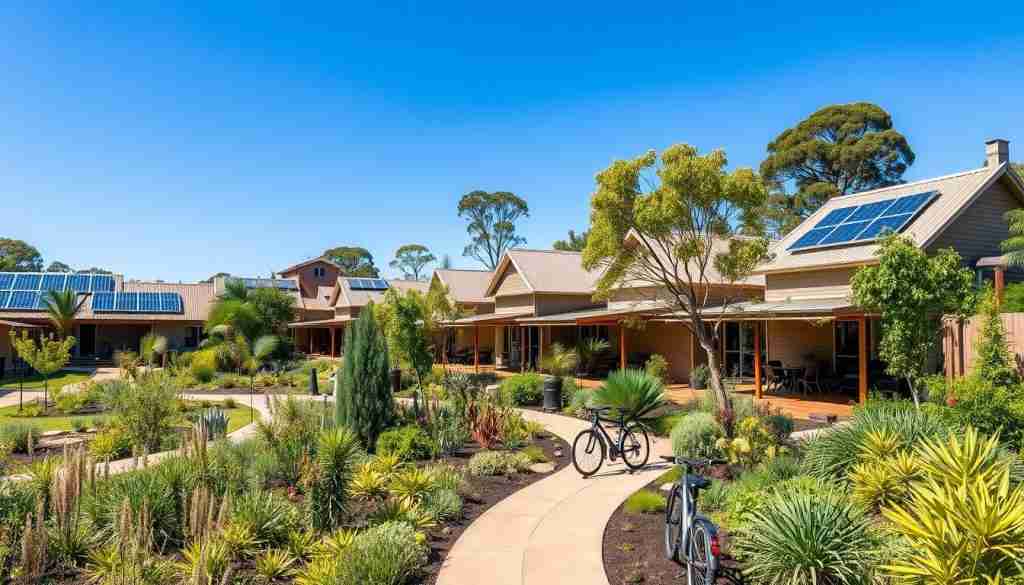
Planning and Building a Co-Housing Project
The first step is to develop a comprehensive plan. This plan should outline the community’s values, goals, and design. You need to find the right location, decide on the number and types of dwellings, and create a layout that promotes social interaction and sustainability.
Consider adding shared spaces like community gardens, playgrounds, and common areas. These spaces encourage a sense of belonging and cooperation.
Securing Land and Funding
Securing land and funding is key to your project’s success. Look for sites that fit your community’s vision and budget. Consider factors like proximity to amenities, public transportation, and green spaces.
Explore funding options like private investments, grants, and loans. Using collaborative financing models can make the project more affordable and accessible.
| Funding Option | Description |
|---|---|
| Private Investments | Community members contribute funds to purchase land and develop the co-housing project. |
| Grants | Seek grants from government agencies or non-profit organizations that support sustainable living initiatives. |
| Loans | Secure loans from financial institutions or ethical lenders that specialize in community-oriented projects. |
| Collaborative Financing | Pool resources among community members to increase buying power and reduce individual financial burdens. |
Engaging Community Members
Engaging potential community members early is crucial. Reach out to those who are passionate about communal living, sustainable living, and alternative housing. Host information sessions, workshops, and social events to attract interested members.
Encourage open communication and active participation in decision-making. This creates a collaborative and inclusive environment.
Navigating Regulations and Zoning Laws
Navigating regulations and zoning laws is a critical aspect. Work closely with local authorities, urban planners, and legal experts. Understand the specific requirements for alternative housing models and be prepared to advocate for your project’s benefits.
Collaborate with experienced professionals to guide you through the planning and development process. They can help you overcome legal or regulatory hurdles.
“Co-housing is not just about creating a place to live; it’s about building a community that supports and enriches the lives of its members.” – Sarah Thompson, Co-Housing Advocate
By following these steps and staying committed to your vision, you can successfully start a co-housing community in Australia. This community will promote sustainable living, communal living, and a strong sense of belonging. Embrace the journey and the challenges, knowing the rewards are well worth the effort.
Benefits of Co-Housing for Families and Individuals
Co-housing communities offer many benefits for people of all ages. They are great for young professionals looking for affordable, green living. They also help seniors find companionship and support.

Co-Housing for Families with Children
Living in a cohousing community is great for families. Parents can share childcare and enjoy a better work-life balance. Kids have lots of chances to play and learn in shared spaces like playgrounds and gardens.
Co-Housing for Seniors
As people get older, they might feel lonely or struggle to find affordable housing. Cohousing communities offer a supportive place to live. Seniors can find friends, join in activities, and feel needed, which helps fight loneliness and depression.
Co-Housing for Young Professionals
Young professionals often find it hard to find housing that fits their values and budget. Cohousing offers affordable, green living with shared resources. It also helps them find a good work-life balance, which many young professionals value.
Co-Housing for Eco-Conscious Individuals
For those who care about the environment, cohousing is a dream come true. It’s designed to be eco-friendly, with shared spaces and resources. People living here work together to make their community sustainable.
| Demographic | Key Benefits |
|---|---|
| Families with Children | Shared childcare, supportive community, communal spaces for socialization |
| Seniors | Companionship, reduced isolation, improved mental health |
| Young Professionals | Affordability, sustainable living, work-life balance |
| Eco-Conscious Individuals | Shared commitment to sustainability, reduced environmental footprint |
Cohousing communities cater to all ages and lifestyles. They offer affordable, sustainable living that builds strong communities. This way, everyone can find a place that supports their well-being.
Co-Housing vs. Other Alternative Housing Models in Australia
In Australia, more people want homes that are good for the planet and bring people together. Co-housing is popular, but it’s not the only choice. Let’s look at how co-housing stacks up against other community-focused housing options.
Co-Housing vs. Tiny Homes
Tiny homes are loved for being cheap and simple. But they’re not like co-housing because they don’t share much space. Co-housing is all about living together and sharing resources. It gives you both your own space and a community feel.
Co-Housing vs. Shared Rental Accommodation
Shared houses or apartments are common in Australia. They’re cheap, but they don’t have the community spirit of co-housing. In co-housing, everyone helps out and makes decisions together. This doesn’t usually happen in shared rentals.
Co-Housing vs. Co-Living
Co-living places, like Common and Hmlet, are similar to co-housing. They focus on shared spaces and amenities. But co-living is more for young professionals while co-housing attracts a wider range of people looking to stay long-term.
Co-Housing vs. Eco-Villages
Eco-villages and co-housing both care about the environment and community. But eco-villages are often in the countryside and focus on being self-sufficient. Co-housing can be in cities or the countryside and aims to be eco-friendly too.
| Housing Model | Affordability | Community Involvement | Environmental Sustainability |
|---|---|---|---|
| Co-Housing | Up to 25% below market rates | High | 35-50% reduction in carbon footprint |
| Tiny Homes | Varies, often more affordable than traditional housing | Low | Depends on design and energy usage |
| Shared Rental Accommodation | Varies, often more affordable than living alone | Low to moderate | Depends on individual practices |
| Co-Living | Varies, often more affordable than traditional housing | Moderate to high | Depends on company policies and practices |
| Eco-Villages | Varies, often more affordable in the long-term | High | High, often off-grid and self-sufficient |
Collaborative housing in Australia has resulted in better housing quality, incentivizing reduced building life cycle costs, such as energy saving initiatives.
Choosing between co-housing and other housing models depends on what you value. By understanding each option, Australians can pick the best fit for their lifestyle and goals for a greener, more connected life.
Challenges of Co-Housing in Australia
Co-housing brings many benefits, but it also comes with challenges. In Australia, setting up a sustainable cohousing development can face financial, legal, and zoning hurdles. It’s crucial to plan carefully to overcome these obstacles and achieve successful communal living arrangements.
Financial Barriers
One big challenge is finding enough money for co-housing projects in Australia. Buying land, designing the community, and building infrastructure costs a lot. Also, ongoing costs like maintenance and utilities need to be budgeted for to keep the project going financially.
Legal and Zoning Issues
Dealing with laws and zoning rules can be tricky when starting a co-housing community in Australia. It’s important to work with local authorities, lawyers, and planners to follow all laws. Different places have different rules, so doing your homework is key.
“Australia’s housing sector heavily relies on private home ownership and private renting. The need for diversification of housing models to meet various housing needs such as key workers, young people, people with a disability, older Australians, and Aboriginal and Torres Strait Islander People is highlighted.” – Sustainable Home Magazine
Interpersonal Conflicts in Co-Housing
Living close together and sharing spaces can lead to conflicts. It’s vital to have good communication, ways to solve problems, and community rules from the start. Regular meetings and open talks can help manage and solve any issues that come up.
Longevity and Maintenance of Co-Housing Projects
Keeping a co-housing project going for the long term needs effort from everyone. A good maintenance plan, cooperative management structures, and a sense of shared responsibility are crucial. Keeping common areas and homes in good shape is important for the community’s quality of life and property values.
| Challenge | Potential Solution |
|---|---|
| Financial Barriers | Explore alternative financing options, such as co-operative funding models and government grants |
| Legal and Zoning Issues | Work closely with local authorities and planning experts to navigate regulations and secure necessary permits |
| Interpersonal Conflicts | Establish clear communication channels, conflict resolution strategies, and community agreements |
| Longevity and Maintenance | Develop a robust maintenance plan and foster a sense of shared responsibility among residents |
By tackling these challenges head-on and using effective strategies, co-housing communities in Australia can thrive. They can offer a sustainable and fulfilling place to live for their residents.
The Future of Co-Housing in Australia
Australia is facing big challenges with housing costs and sustainability. Co-housing is seen as a key solution. It’s about living together in a way that’s good for the planet and for people of all ages. Let’s look at what’s shaping the future of cohousing here.
Government Policies and Support
Government support is crucial for co-housing to grow in Australia. Things like grants and tax breaks can help. They make it easier to build affordable, green homes.
By seeing the good co-housing does for society and the environment, governments can help it thrive. This creates a better place for everyone to live.
Sustainable Living Trends
More people want homes that are good for the planet. Co-housing fits this bill with its focus on being green. It uses less energy and has lots of green spaces.
This trend will keep co-housing popular. People want to live in a way that’s kind to the earth.
Technological Innovations in Co-Housing
New tech is changing co-housing for the better. Things like smart homes and green energy make living together easier. They help us use less and communicate better.
As tech keeps getting better, so will co-housing. It will become even more sustainable and connected.
“Co-housing offers a unique opportunity to create sustainable, affordable, and socially connected communities. By embracing technological innovations and sustainable design principles, co-housing can redefine the way we live and interact with each other.”
– Sarah Thompson, Co-Founder of Sustainable Home Magazine
Expansion into Urban and Rural Areas
Co-housing is not just for cities anymore. It’s also heading to rural areas. This offers a chance for a greener, more community-focused life outside cities.
This move will make co-housing available to more people. It will meet different needs and preferences across Australia.
| Co-Housing Model | Key Features | Benefits |
|---|---|---|
| Urban Co-Housing |
|
|
| Rural Co-Housing |
|
|
The future of co-housing in Australia is bright. More people want to live in a way that’s good for the planet and for each other. With the right support, co-housing will become a common choice for those seeking a better way to live.
How to Find a Co-Housing Community in Australia
If you’re looking to join a cohousing community in Australia, there are many ways to find the right one. With more people interested in living together, there’s a lot of help out there. You can find a community that matches your lifestyle and values.
Start by looking online. Sustainable Home Magazine and other websites have articles and lists of cohousing communities. Cohousing Australia’s website is also a great resource, with info on communities and how to start your own. You can also find groups and events on Facebook and Instagram.
Attending Co-Housing Events and Meetups
Going to cohousing events and meetups is a great way to learn more. These events have workshops and discussions on living together. You can meet people and learn about their experiences.
Visiting Existing Co-Housing Communities
Visiting cohousing communities in person is another good idea. Many communities offer tours and open houses. This lets you see the community and meet the people who live there.
Joining an Intentional Co-Housing Community
If you find a community you like, you can join. Communities have a process for new members, like filling out an application. This helps make sure everyone fits in and is committed to the community.

